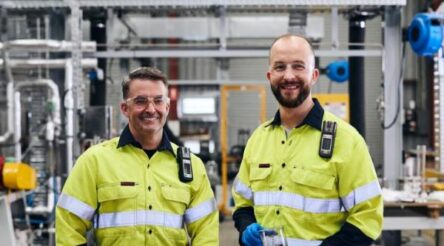A new deal plan for manufacturing – a post COVID-19 reset by Andrew Stevens

The Australian Manufacturing Forum and @AuManufacturing’s campaign to crowd source a new deal plan for manufacturing is now in its second-last day. Here Andrew Stevens discusses three characteristics shared by successful manufacturers, and why they are vital in a post COVID-19 reset.
I was privileged to have been the Chair of Australia’s Advanced Manufacturing Growth Centre (AMGC) from 2015 until 2019.
During that time, AMGC studied the dimensions of manufacturing success and failure – across Australia and across the world – and developed a view on the competitiveness of Australian manufacturing and Australian manufacturers. In the process we documented the characteristics of Australia’s and the world’s most successful manufacturing companies. Despite operating in different countries with different shareholders, tax rates, incentive regimes and serving different markets, their characteristics were astonishingly similar.
I have just spent some time reviewing these characteristics of manufacturing success and failure in the context of the COVID-19 “recovery” and “new normal” phases. To say that the post COVID-19 world provides Australian Manufacturing and Australian Manufacturers with both an opportunity and a requirement to reset is an understatement.
So while most will want to focus on what the Commonwealth and State/Territory governments can do to make manufacturing businesses more successful, it is appropriate to examine the actions which should be a part of every manufacturing business’ reset plan for the post COVID-19 world.
Highlighted here are three key characteristics that should be considered as part of any Australian manufacturer’s post COVID-19 reset plan:
1. Reset to compete more on value and less on cost
In the five and a half years since manufacturing success became my focus, I am yet to see one Australian business that has a significant and growing market share based on competing on cost leadership. Companies for which cost and price leadership are their primary competitive weapons are consistent underperformers in Australia. They grow at lower rates or decline, and they employ fewer people.
Conversely, Australian and international manufacturing companies that compete strongly on value differentiation (and much less on cost and price leadership) share consistent revenue growth and strong margins.
2. Reset to add greater value before and after production
Production is merely one facet of manufacturing. In fact, the OECD (Interconnected economies benefiting from global value chains – OECD 2013) published what successful manufacturers know well – the customer value generated in “production” is declining and declining quickly.
Customer value is increasingly being created on either side of the production stage in the manufacturing value chain, product design (before) and services provided (after production). Without getting too complex, “design value” and “services value” are both intangible in nature. Appearance, feel, ease of use, confidence, trust and privacy are all intangible value characteristics – and they are increasingly being provided using software enabled processes.
If you consider your smart phone, the production cost of your phone is about five per cent of its sales price. Ninety-five per cent of the sale price (and therefore 95 per cent of the value delivered to customers) is in the design and service (which includes warranty) which are vital parts of your phone purchase choice. This is a clear example of greater value adding before and after production.
3. Reset to invest more in innovation, whether it be in Research and Development (R&D) or non-R&D in nature
It would be unrealistic to reset to compete more on value and to add more of that value before and after production without a change to investment levels and types of investments. Investment in innovation is a key determinant of success in manufacturing (indeed in virtually every sector).
I’m currently the Chair of Innovation Science Australia (ISA), the Government’s strategic advisor on innovation policy. Our recent report Stimulating Business Investment in Innovation found that:
- Only six per cent of Australian businesses tell Australian Bureau of Statistics (ABS) that they invest in Research and Development,
- Less than a third of all businesses (31 per cent) tell the ABS that they invest in any form of innovation (R&D and non-R&D in nature), and
- eighteen per cent of the cross-section of businesses interviewed during ISA’s analysis demonstrated more than one of these four key characteristics which are common in successful innovators:
- Investing in considered decision-making processes,
- Engaging investors and staff to innovate,
- Responding to the needs of their customers and potential customers, and
- Actively engaging with external partners and collaborating effectively.
- Of the remaining 82 per cent of businesses, most had one or none of these characteristics in place.
As you will see in our report, ISA also studied the impact that different investment levels in non-R&D innovation had on company growth rates. Using software expenditure as an indicator of non-R&D Innovation levels we found that:
- The median level of expenditure on software for small and medium (SME) businesses is two per cent of revenue,
- SME firms which invested more than the median two per cent in software grew revenue on average 3.5 ppt (i.e. 350 basis points) faster than those which invested less than the median two per cent,
- SME firms again which invested more than the median created jobs 5.2ppt (520 basis points) faster than those which invested less than the median, and
- The same growth and job creation uplifts albeit at slightly lower premiums were also enjoyed by ASX 200 companies which invested above the median level.
When we observe that our leading manufacturing companies (CSL, Cochlear, Resmed, ANCA, Sutton Tools, Textor,…) invest more than 10% of revenue in innovation, we see why they have become leaders in their market segments and why they stay leaders.
The need for, and the magnitude of, the reset for most manufacturers in Australia is underscored by this final point. If we are wondering why we do not have more successful manufacturers in Australia, we need look no further.
The COVID-19 crisis has shown to all Australians the importance of manufacturing and has given rise to fresh consideration of our sovereign manufacturing capability. But there is more to it than that.
Sovereign capability and industry advantage (inclusive of both competitive and comparative advantage) are vital elements in a new era for Australian manufacturing and Australian manufacturers.
While manufacturers can and must lead the reset, the Commonwealth and State/Territory governments have an opportunity, no – a requirement, to encourage and accelerate the transition to more value-based manufacturing models.
Andrew Stevens is Chair, Innovation and Science Australia.
@AuManufacturing’s new deal plan for manufacturing is brought to you with the support of Bosch Australia Manufacturing Solutions

Subscribe to our free @AuManufacturing newsletter here.
@aumanufacturing Sections
Analysis and Commentary Awards Defence Manufacturing News Podcast Technology Videos










